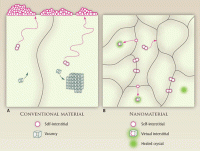Nanomaterials are immune to radiation

New nuclear build, both fusion and fission, now seems inevitable in many countries. Crucial to the safety and lifetime of reactors is the degradation of the steels from which they are made due to radiation. The ability of a material to resist radiation damage is determined by how well the microstructure can remove vacancies and interstitial defects in equal numbers. In this week's Science, Prof Graeme Ackland proposes that nanomaterials can be used as catalysts for healing damage, or as nanodustbins for storing embrittling byproducts such as Helium.

